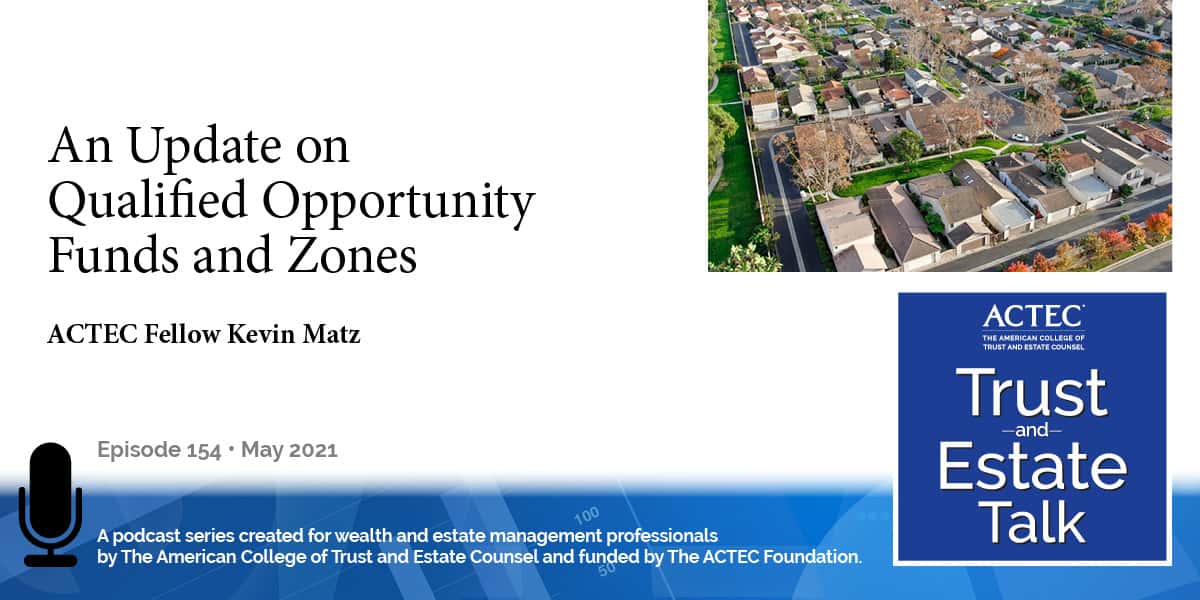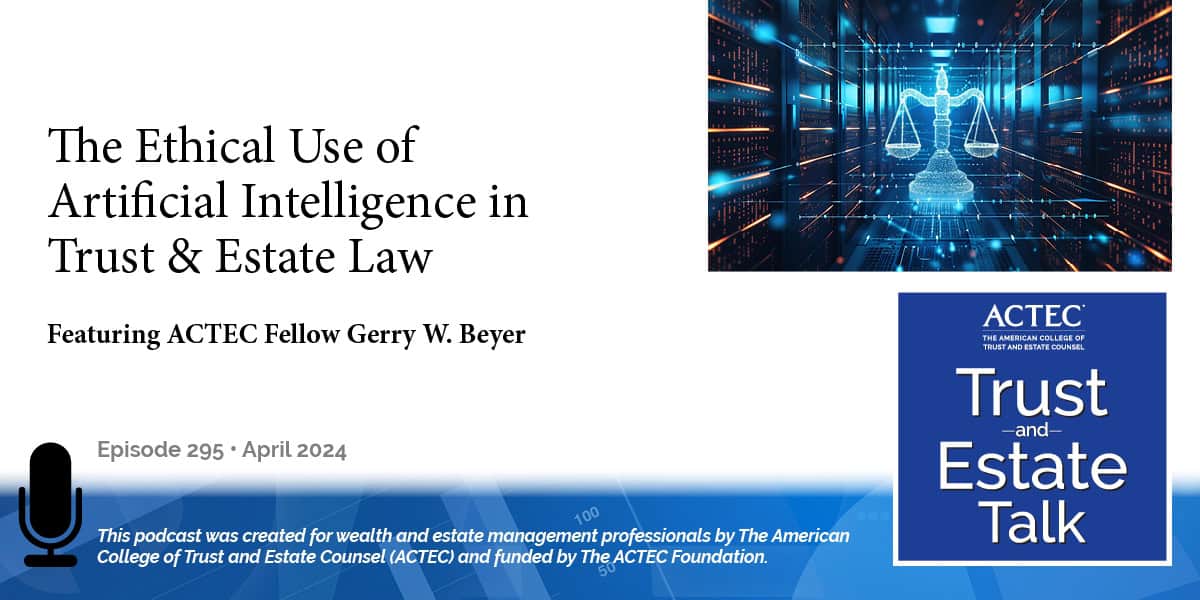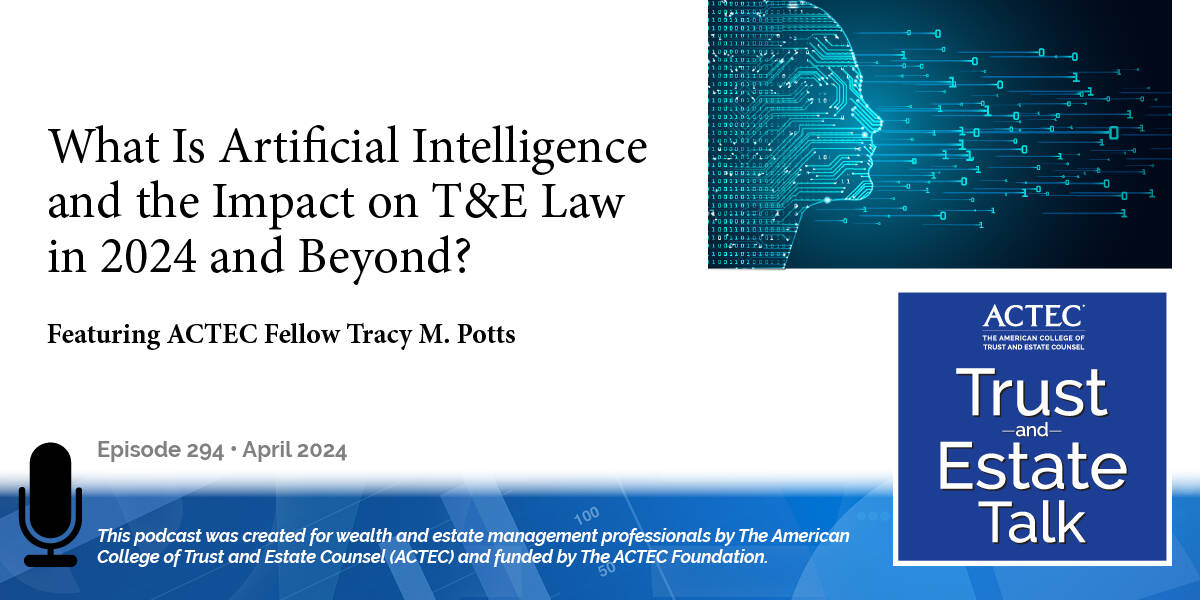An Update of Qualified Opportunity Funds and Zones

“An Update on Qualified Opportunity Funds and Zones,” that’s the subject of today’s ACTEC Trust and Estate Talk.
Transcript/Show Notes
This is Doug Stanley, ACTEC Fellow from St. Louis, Missouri. The IRS recently released guidance that provides relief to funds and investors in the area of qualified opportunity funds and qualified opportunity zones. To update us on this topic, we are bringing back ACTEC Fellow Kevin Matz of New York City. Welcome back, Kevin.
Well thank you, Doug. And hello, everyone. So, qualified opportunity funds and opportunity zones. I’m going to set the table a little bit. So, again, this was introduced as far as the Tax Cuts and Jobs Act from 2017. And its purpose here is to promote investment in economically distressed communities, referred to as opportunity zones. And through this program, investors can achieve three primary objectives. So, this is from the investor standpoint. Why would they invest? How would they be encouraged by Congress to invest?
Opportunity Zones as an Investment
Number one, they can achieve a deferred gain on the disposition of property to an unrelated person until the earlier to occur. So, it’s two dates – earlier of two dates. The date on which a property is – the investment is, rather, sold or exchanged – or as an outside date, December 31, 2026. Parenthetically, I like to refer to that sometimes as the “Judgment Day.” I guess I’ve been watching too many “Terminator” movies. So long – they have to do this though – the gain has going to be reinvested in a qualified opportunity fund with 180 days to the property’s disposition.
So, again, you get deferral – possibly to December 31, 2026 – but to do that, the ticket is within the 180 days or 180 deemed days – we’ll talk about that shortly. You have to invest in this new animal. This new creature of statute called the qualified opportunity fund. How to qualify as a qualified opportunity fund? It’s self-certified. That’s a whole topic for itself. Another topic for another day.
Secondly, second big benefit that can be achieved here – and, again, this is all with the goal here of driving investment in these economically distressed communities. These opportunity zones. The vehicle forward is the qualified opportunity fund. So, the second big advantage for taxpayers – for doing this – is elimination of some amount of the gain that’s been reinvested in the qualified opportunity fund, provided that certain holding period requirements are met. Basically, you start out with – you defer the gain until the earlier to occur of the disposition or Judgment Day, December 31, 2026, as a possible outside date. And the mechanism to preserve the gain for a later date, is that you start out with a zero basis in the investment.
So, you have a deferred gain. Congress in its wisdom said, we want to encourage long-term investment. So, we’re going to reward investors who hold the investment for five years. You’ll get a 10 percent basis step-up. Basically, make 10 percent of the gain disappear. And if you happen to hold the investment for seven years through that outside date of December 31, 2026 – Judgment Day – you can get 5 percent basis step-up on top of that. So, 15 percent overall. So, that’s number two. Possible basis step-up to eliminate some portion of gain.
And then, thirdly – because the goal here is not just for investors to go in and out and invest in these qualified opportunity funds, which in themselves invest in the qualified opportunity zone property including some qualified opportunity zone businesses in areas that are considered economically distressed. All, by the way, by virtue of the 2010 census, way back in rearview window, but that’s what we’re dealing with here.
The third advantage to have really long-term investment is – Congress said, okay, if you hold your investment for more than 10 years, yeah, you’re going to have the Judgment Day. You’re going to have to pay tax, ultimately, come December 31, 2026 as an outside date. That’llstep up your basis, to where you otherwise would’ve been. But if you have appreciation in the value of the investment and you hold the investment in the qualified opportunity fund for more than 10 years – and let’s say it really, really grows in value – becomes a big homerun. That appreciation is not subject to tax at all. Completely avoids tax.
So, three key benefits, again. Deferral of gain, possibly, and it has to be capital gain, by the way. It has to be capital gain. But possibly until December 31, 2026 – the Judgment Day as the outside date. That’s Number one. Number two, possible elimination of gain by the basis-step-up mechanism with a 5-year or 7-year hold. And then thirdly, which many regard as the crowned jewel here, if you hold the investments for more than 10 years and there’s appreciation in value, all that avoids tax whatsoever on the appreciation. Very, very significant.
Final Regulations for qualified opportunity funds
So, we got final regulations in qualified opportunity funds. There were proposed regulations – ACTEC commented on. Treasury heeded some of our comments. Did not heed others of them. We had final regulations in December 2019. One thing to bear in mind with the final regulations. Very important.
I talked about – there are two triggers to when you can have the disposition with a deferral of gain become activated, so the deferral ends. The earlier of a disposition or December 31, 2026. The statute actually says, not disposition, but sale or exchange. However, Treasury in its regulations, including in final regulations said, well, even though its statute says sale or exchange, if you have a gift and it’s not to a grantor trust or other disregarded entity, if you have a gift – and, again, it’s not to a grantor trust – that’s going to be a deemed disposition. Something to bear in mind. That was – ACTEC in its comments addressed it. I think we made a very credible argument, but unfortunately it was not heeded by Treasury.
2020 – 2021 and qualified opportunity funds
Fast forward the clock to 2020. Okay. What happened? Well, to anyone in the audience who’s listening to this knows what 2020 has been all about. It’s the year that, hopefully, will never be repeated again. COVID. The COVID-19 pandemic. The economic recession. And all this hit qualified opportunity funds and opportunity zones very, very hard.
And the concern was, well, the investors – they may have their capital gains but they’re not going to invest in the qualified opportunity funds. Why? Because with everything going on, they really need the money. Or maybe they have losses that they could use to offset against it. Capital losses to offset against it. And the opportunity zone businesses that are set up, be it real estate or it could also be operating businesses. Well, how’s that working out in the time of COVID and pandemic and everyone wearing masks and the like? Not so well.
So, Treasury was concerned about this. And on three different occasions, Treasury and the IRS provided postponement relief, which is very, very significant. They did that firstly with IRS Notice 2020-23 in April 2020. Then secondly, in June 2020 they issued Notice 2020-39. And then more recently, which brings us up to date here, on January 19th, 2021, the IRS issued Notice 2021-10, which is designed to provide further opportunity zone relief due to the COVID-19 pandemic.
So, what did this Notice 2021-10 do? It provided five key benefits. Five, basically, lifesavers – in lack of a better word – for qualified opportunity funds, qualified opportunity zone businesses and to drive investment by taxpayers with capital gains into the qualified opportunity funds.
So number one, to encourage investment, because again, people saying, well, I would love to invest my capital gain within 180 days or 180 deemed days with the qualified opportunity fund, but I really need the money, especially with a pandemic going on and the like. Treasury said, okay, we’re going to relax the 180-day rule. And we’re going to extend it. And we’re going to say that, generally, at the 180 days – deemed days to invest. But if the 180 period, including deemed days period, comes within the period of April 1, 2020 and March 31, 2021, the last day of that 180-day investment period is postponed all the way to March 31, 2021.
That ladies and gentlemen – today is March 12th, 2021, the day I’m recording this. It is quite possible you’ll be listening to this afterwards. It’s also quite possible that the IRS may provide further relief. I guess, stay tuned after that. This relief, by the way, is automatic. Although the investor still needs to make a valid deferral election in a timely filed tax return, including extensions. Which means that if a return has been filed and it hasn’t been claimed, you have to go back. You have to amend the return if applicable. So, that’s number one.
Secondly – for the actual qualified opportunity funds– again, how are they going to meet the various tests? There’s this 90 percent test. They have to, basically, have 90 percent of their assets, after a certain period of time, invested either directly in qualified opportunity fund investments or through a qualified opportunity zone business – a second-tier entity that this statute and the regulations permit. Which, basically, I’m finding almost everyone does because it provides a significant relaxing of the rules, including the asset holding requirements that apply. There is, still, at the qualified opportunity fund level – considering that. Taking that into account a 90 percent investment standard.
Needless to say, it’s hard to beat that standard if you’re concerned about everything going on with the economy and the pandemic. Treasury was mindful of that and basically said that if you have any failure to reach this 90 percent standard for the period that’s between April 1, 2020 and ending on June 30, 2021, any failure is deemed to be okay. Disregarded due to reasonable cause. And you don’t have to worry about it. It’s basically a free pass. That relief is automatic.
The third aspect of the relief provided by Notice 2021-10 concerns what’s known as a deferral or basically a suspension of the 30-month substantial improvement period for qualified opportunity funds and qualified opportunity zone businesses. Basically, in order for this statutory structure to work, you have to actually have investment in the economically distressed communities, be it by the fund itself or more commonly through a drop-down, second-tier entity of the qualified opportunity zone business.
Now the way it works is there are two different tickets to get there. You could have original purchase. Original acquisition of it. Or you could take a property and substantially improve it, which is defined as at least doubling its tax basis over a period. And that period is 30 months. Of course, COVID intervened, and Treasury was very mindful of this and said that for the period that begins on April 1, 2020 and ending March 31, 2021, we’re going to disregard that one-year period from entering into the determination of whether or not you’ve met the 30 month substantial improvement requirement to double – at least double the original cost basis of the property. So, very helpful there.
Fourth item out of five. There’s a working capital safe harbor when you have qualified opportunity zone businesses. And it basically says that’s okay, and this is part of the advantage of having that second-tiered entity for the qualified opportunity zone businesses. General rule is you can only have five percent of your assets invested in certain financial property. However, and this is a huge exception to it, this working capital exemption says as long as you have holdings in cash, cash equivalents, and debt instruments, and comply with certain requirements set forth in regulations and also in the IRS Form 8996 for qualified opportunity funds, you can have an additional 31 months to basically deploy the capital. And you still get treated as being a valid qualified opportunity zone business, which in turn allows it to be treated at going to the 90 percent test. So, 31 months. Very significant.
But at this point of recording today, we’re already 12 months into COVID, and who knows how much longer this is going to extend? Hopefully, not too much longer, but it’s a concern. So, what Treasury said is, we’re going to give you an additional 24 months on top of that. So, from 31 months – potentially to 55 months – if you have certain startups, you actually get to have a 62-month period instead of 31 months. Rules a little bit technical there. But you still get the benefit of an additional 24 months. And this is intended to cover the working capital safe harbor to extend and apply through June 30, 2021. So, very, very significant.
And then lastly, where you have a sale of the interest in the qualified opportunity fund, or you have a qualified opportunity fund that sells its assets or a qualified opportunity zone business, what the statute allows – the qualified opportunity fund statute 1400Z – it says that you get 12 months to figure out how to reinvest in another qualified opportunity fund. Well, 12 months – of course we’ve been in COVID and the pandemic now for more than 12 months, and Treasury was concerned about it. So, they said, okay – if you happen to have a situation where if you have a 12-month period and it embraces, now the date of June 30, 2020, which is looking backwards – June 30, 2020 because it didn’t roll forward 12 months from that – we’re going to tack on an extra 12 months. We’ll give you 24 months as a reinvestment period for qualified opportunity funds. So, that is my summary of IRS Notice 2021-10 and further opportunity zone relief due to the COVID-19 pandemic. Thank you, and enjoy your day.
Thank you, Kevin, for this update on qualified opportunity funds and zones.
You may also be interested in:
- Qualified Opportunity Funds and Opportunity Zones – November 2019
- Qualified Opportunity Funds and Opportunity Zones – April 2019
This podcast was produced by The American College of Trust and Estate Counsel, ACTEC. Listeners, including professionals, should under no circumstances rely upon this information as a substitute for their own research or for obtaining specific legal or tax advice from their own counsel. The material in this podcast is for information purposes only and is not intended to and should not be treated as legal advice or tax advice. The views expressed are those of speakers as of the date noted and not necessarily those of ACTEC or any speaker’s employer or firm. The information, opinions, and recommendations presented in this Podcast are for general information only and any reliance on the information provided in this Podcast is done at your own risk. The entire contents and design of this Podcast, are the property of ACTEC, or used by ACTEC with permission, and are protected under U.S. and international copyright and trademark laws. Except as otherwise provided herein, users of this Podcast may save and use information contained in the Podcast only for personal or other non-commercial, educational purposes. No other use, including, without limitation, reproduction, retransmission or editing, of this Podcast may be made without the prior written permission of The American College of Trust and Estate Counsel.
If you have ideas for a future ACTEC Trust & Estate Talk topic, please contact us at ACTECpodcast@ACTEC.org.
© 2018 – 2024 The American College of Trust and Estate Counsel. All rights reserved.
Latest ACTEC Trust and Estate Talk Podcasts

The Ethical Use of Artificial Intelligence in Trust & Estate Law
A law professor offers insights into the risks, rewards, duties and ethical considerations of lawyers using AI in their T&E practices.

What Is Artificial Intelligence and the Impact on T&E Law in 2024 and Beyond?
A primer on the types and uses of AI, then a deeper dive into the impact on trust and estate law from types to applications to ethical considerations.

The IRS Ruling on Modifying a Grantor Trust
Explore the gift tax implications for trust beneficiaries modifying grantor trusts in IRS CCA 202352018, with nuanced analysis and estate planning insights.

